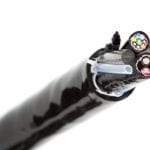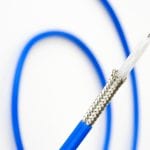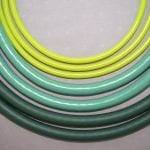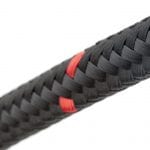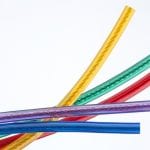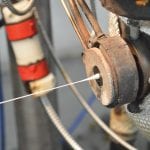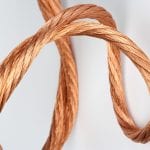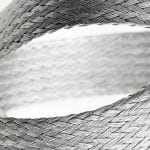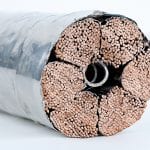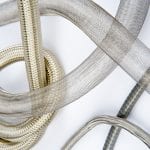What Is Induction Heating?
Induction heating relies on the existence of eddy currents discovered by Léon Foucault in 1855. Briefly, when a changing magnetic field passes through any conductive object, current flow is induced in the object. That current flow creates a secondary electric field in the conductor. The secondary electric field, in turn, produces another flow of current which is known as the eddy current, so named because it flows in a circular pattern, much like water can swirl in a slow-moving stream when it encounters an obstacle. The push-pull between these fields—literally, the kinetic energy caused by electrons being shuttled back and forth—produces heat in the conductor.
This use of eddy currents can not only cook a meal; it can melt steel and other metals.
Induction Heating Applications
Induction heating is used to manufacture end items as diverse as bulldozers, spacecraft, faucets and sealing plastic lids on pharmaceutical bottles. The fundamental design of an induction heating device uses a coil of wire and an AC current to induce a changing magnetic field in the item to be heated—the work piece. The coil can measure only a few centimeters in diameter, or any other dimension suited to the job at hand.
The work piece is placed inside the magnetic field generated by the coil, but not in contact with it, then heated to the desired level by the eddy currents. Depending upon the material being heated, temperatures as high as 2,200° F (1,200° C) can be achieved.
Induction heating is clean, requiring no fossil fuels. Parts exposed to induction heating simply heat up, so there’s no cleanup afterward and no worry about contamination of the work piece. It’s also fast. For example, manufacturers of pipes and tubular channels use induction heating to weld a seam along the longitudinal dimension of pipes passing by at high speed on a conveyor.
A few other processes that use induction heating include: 
- Induction hardening and tempering, which alters the physical characteristics of materials to meet the needs of various applications.
- Induction melting can be used to melt any ferrous or non-ferrous metal, including nuclear material and various alloys used in medicine and dentistry.
- Metal and carbon fiber materials can be bonded together by heating them, thereby curing adhesives placed between two surfaces.
- Soldering, brazing and welding are all natural applications for induction heating where precise temperature control and accurately confining heat to the desired area is important.
Induction Heating Solves Real Problems
The so-called Tylenol Murders took place in Chicago during 1982 when someone, never identified, laced Tylenol bottles with cyanide. The subsequent events led to a nationwide recall of Tylenol products. The poisoning also forced the entire over-the-counter pharmaceutical industry to package their products in tamper-proof containers.
The aluminum foil that’s commonly used to seal OTC drugs is part of the industry’s solution, and it uses induction heating. The process begins by placing the foil, which is electrically conductive, into the cap. The cap is screwed down, then the entire package is placed inside an induction heating coil. As the foil heats up, adhesives around its edge adhere it to the lip of the bottle.
Designers of induction cap sealing equipment must take several factors into account. The induction heater’s physical dimensions need to be tailored to the containers to be sealed. The electromagnetic field needs a depth suitable for heating the foil. The heating should take place as quickly as possible for productivity reasons. The efficiency of the induction heater needs to achieve a specific performance level.
These and other design constraints can be reduced dramatically when the wire used to make the coil is custom-manufactured. New England Wire Technology, a long-time supplier to the induction heating market, provides wire specially made to solve such design problems.
For instance, NEWT can supply round, square and rectangular conductors. Their exact size can be tailored specifically for the AC current and frequency to be used. And, because the efficiency can be optimized in the wire itself, the induction cap sealer design engineer has much greater flexibility in choosing the spacing, shape and size of the sealing head. In fact, that same flexibility benefits designers of any induction heating device.
The Case for Litz Wire
Induction heaters can run on AC power ranging from a few Hertz to 500 kHz and higher. The frequency chosen determines the heat’s penetration depth, with lower frequencies penetrating deeper. Frequencies for induction heaters are chosen at design time according to the particular work to be accomplished. For instance, an application that calls for hardening and a deep penetration uses low frequency. Another application that calls only for surface heating would use high frequency.
Higher frequencies passing through a wire cause the skin effect where much of the current flow travels along the outside of the wire, increasing its AC resistance and creating unwanted heat. Using NEWT’s unique Litz wire to build the coil virtually eliminates the skin effect, making the coil more efficient and allowing for more modest, lower cost power supply designs. (Read more about Litz wire).
Still, Challenges Do Arise
Because induction heating is used in so many applications, converting a customer’s design needs into a suitable Litz wire product involves many factors. According to NEWT engineers, “Almost every induction heating project takes on aspects of a custom job. While building wire and cable to customer specs seems simple, the number of variables that go into a solid design can be numerous.”
For instance, the wire size can be adjusted for the AC frequency to avoid skin effect and other losses in the coil. Then, the total number of conductors in the Litz wire can be chosen to accommodate the maximum current flow. Conductors that make up the Litz wire are insulated using a film that needs to accommodate certain temperatures. Case in point: an induction coil used to heat a large vat of steel has to work in a much hotter environment than one used to seal aspirin bottles. Likewise, the outer insulation needs to protect the high voltages often used, as well as environmental conditions.
Custom Design Services to the Rescue
The solution to these challenges lies in NEWT’s custom design service staff. That team, consisting of a knowledgeable sales staff supported by design and manufacturing engineers, has helped customers worldwide achieve the best solutions. Be sure to contact us to discuss your next induction heating project.
Custom Design

About Our Engineers
Innovative solutions start with an experienced team of engineers, armed with the latest design tools and technology. Our focus on understanding the individual, complex challenges of our customers and designing solutions that fit, is why we have been trusted as the industry leader for over 100 years.







